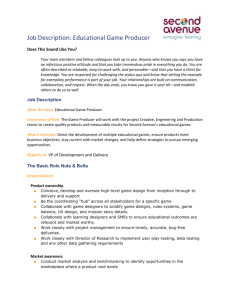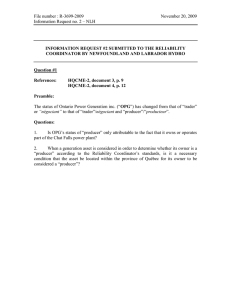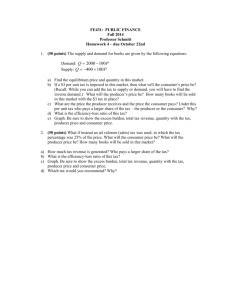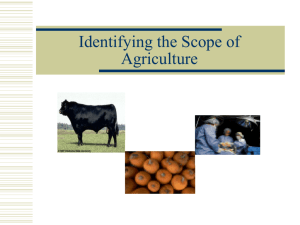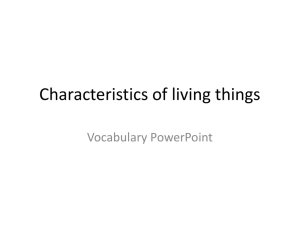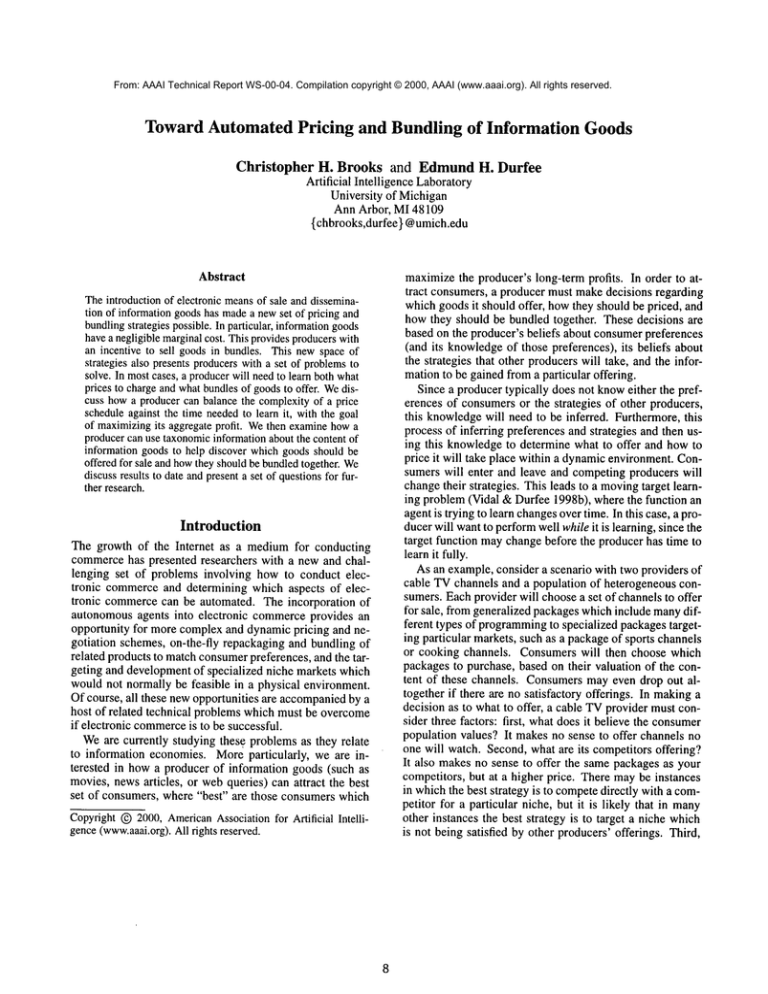
From: AAAI Technical Report WS-00-04. Compilation copyright © 2000, AAAI (www.aaai.org). All rights reserved.
Toward AutomatedPricing and Bundling of Information Goods
Christopher
H. Brooks and Edmund H. Durfee
Artificial Intelligence Laboratory
University of Michigan
Ann Arbor, MI 48109
{ chbrooks,durfee } @umich.edu
Abstract
Theintroductionof electronic meansof sale and dissemination of informationgoodshas madea newset of pricing and
bundlingstrategies possible.In particular, information
goods
havea negligiblemarginalcost. Thisprovidesproducerswith
an incentive to sell goodsin bundles. This newspace of
strategies also presentsproducerswitha set of problemsto
solve. In mostcases, a producerwill needto learn bothwhat
prices to chargeand whatbundlesof goodsto offer. Wediscuss howa producercan balance the complexityof a price
scheduleagainst the time neededto learn it, with the goal
of maximizingits aggregateprofit. Wethen examinehowa
producercan use taxonomicinformationabout the content of
informationgoodsto help discover whichgoodsshould be
offeredfor sale and howthey shouldbe bundledtogether. We
discussresults to date andpresenta set of questionsfor further research.
Introduction
The growth of the Internet as a mediumfor conducting
commercehas presented researchers with a new and challenging set of problems involving how to conduct electronic commerceand determining which aspects of electronic commercecan be automated. The incorporation of
autonomousagents into electronic commerceprovides an
opportunity for more complexand dynamic pricing and negotiation schemes, on-the-fly repackaging and bundling of
related products to matchconsumerpreferences, and the targeting and developmentof specialized niche markets which
wouldnot normally be feasible in a physical environment.
Of course, all these new opportunities are accompaniedby a
host of related technical problems which must be overcome
if electronic commerce
is to be successful.
Weare currently studying these problems as they relate
to information economies. More particularly, we are interested in howa producer of information goods (such as
movies, newsarticles, or webqueries) can attract the best
set of consumers, where "best" are those consumerswhich
Copyright© 2000, AmericanAssociationfor Artificial Intelligence(www.aaai.org).
All rights reserved.
maximizethe producer’s long-term profits. In order to attract consumers, a producer must makedecisions regarding
whichgoods it should offer, howthey should be priced, and
howthey should be bundled together. These decisions are
based on the producer’s beliefs about consumerpreferences
(and its knowledgeof those preferences), its beliefs about
the strategies that other producerswill take, and the informationto be gained froma particular offering.
Since a producer typically does not knoweither the preferences of consumersor the strategies of other producers,
this knowledgewill need to be inferred. Furthermore, this
process of inferring preferences and strategies and then using this knowledgeto determine what to offer and howto
price it will take place within a dynamicenvironment.Consumers will enter and leave and competing producers will
changetheir strategies. This leads to a movingtarget learning problem(Vidal &Durfee 1998b), where the function
agent is trying to learn changesover time. In this case, a producer will wantto performwell while it is learning, since the
target function maychange before the producer has time to
learnit fully.
As an example, consider a scenario with two providers of
cable TVchannels and a population of heterogeneous consumers. Eachprovider will choosea set of channels to offer
for sale, from generalized packages whichinclude manydifferent types of programming
to specialized packages targeting particular markets, such as a packageof sports channels
or cooking channels. Consumers will then choose which
packages to purchase, based on their valuation of the content of these channels. Consumersmayeven drop out altogether if there are no satisfactory offerings. In makinga
decision as to what to offer, a cable TVprovider must consider three factors: first, what does it believe the consumer
population values? It makes no sense to offer channels no
one will watch. Second, what are its competitors offering?
It also makesno sense to offer the same packages as your
competitors, but at a higher price. There maybe instances
in whichthe best strategy is to competedirectly with a competitor for a particular niche, but it is likely that in many
other instances the best strategy is to target a niche which
is not being satisfied by other producers’ offerings. Third,
what will a provider learn from offering a particular bundle
of channels? Since a provider typically does not knowexactly what information content is preferred by consumers,
it must explore the space of possible offerings. Even if a
particular bundleof channelsdoes not sell particularly well,
it maybe very useful in helping the provider to learn what
consumersdo (and do not) prefer.
Traditionally, these decisions have been madeby humans.
Cable TV providers change their programmingvery infrequently, since there is a large cost to doing so. The incorporation of autonomousagents into the electronic packaging and distribution of information changes this dynamic,
makingit possible for providersto reorganize their offerings
more easily, while hiding this complexity from the humans
in the system, be they producers or consumers.
In this paper, we begin by discussing howan information goodsproducercan select a pricing strategy to use, balancing the profits to be gained from learning a particular
schedule against the complexity of learning that schedule.
Followingthis, we discuss somecharacteristics of information goods that producers can exploit whenlearning about
consumerpreferences over these goods. Wedescribe how a
producer can use taxonomic information about information
goodsto potentially speedup their learning, and describe our
current research regarding learning of consumerpreferences
in competition with other producers.
Information
Goods
Informationgoods, whendistributed electronically, are typically assumedto have a high fixed, or first-copy, cost, and
a negligible marginal cost. This meansthat once one copy
is purchasedby a producer, additional copies can be created
virtually for free. This makesbundling of information goods
an appealingstrategy; if a producercan reproducearticles at
a very small cost, it can create a bundleof different articles
which appeal to different sets of consumertastes. For example,rather than selling a sports article and a newsarticle
separately for $1 each, a producer could sell both together
for $1.50. A consumerwhovalued the sports article at $1
and the newsarticle at $0.50 (or vice versa) wouldbuy the
bundle,yielding moreprofit for the producerthan if the articles were sold individually at $1 apiece, wherethe consumer
wouldonly buy one article. This opens up a whole new set
of potential pricing schedulesfor a producer.The first question we have examinedis: howa producer can select from
amongthese schedules, given that it does not typically know
consumervaluations ?
Learning Price Schedules
Initially, we examineda system in which an information
goods producer offered a set of goods according to a fixed
price schedule and consumerswere able to choose the subbundle of goods that they wantedfrom this set. This freed
the producer from the problem of selecting which goods to
offer and allowed us to focus on the question of determining
what price schedule a producer should employ.
Weconsidered five pricing schedules:
¯ Per-article (linear) pricing. Consumerspay a fixed price
for eacharticle.
¯ Pure Bundling. Consumerspay a fixed price for the entire
collection of articles.
¯ Two-parttariff. Consumerspay an entry fee, plus a perarticle price for each article.
¯ Mixedbundling. Consumersare offered a choice between
a per-article price and a pure bundleprice.
¯ Nonlinear pricing. Consumerspay a different price for
each article consumed.
The first two schedules have one free parameter, the second two have two free parameters, and the last has N free
parameters, whereN is the total numberof articles for sale.
In a steady-state, perfect information systemwith heterogeneous consumertastes, price schedules with more free parameters allow a producer to extract moreprofit, since they
allow a producerto moreaccurately fit its price scheduleto
the consumerdemandcurve. (See (Brooks et al. 1999) for
details). Since a producerhas perfect information, the problem reduces to finding the schedulewith the highest equilibriumprofit and alwayschargingthat at each iteration.
Whenthe producer has to learn the parameters of a price
schedule, the problem changes. In this case, the producer
mustconcernitself with aggregateprofit. It is not enoughto
eventually find a profitable schedule; a producer should try
to maximizeits total revenue over time.
Weconducted a set of experiments to determine both how
difficult each price schedule was to learn and also howmuch
aggregate profit a producer would accumulate while learning. Weused two different learning methods: a neural networkand amoeba(Press &others 1992), a hill-climbing algorithm for nonlinear optimization. A significant difference
betweenthese algorithms is that the neural networktries to
learn the entire profit landscape (mappingsfrom prices to
profit for all inputs), whereasamoebastrictly tries to find
the global optimumof the profit function without retaining
any state about the landscape. For problemswith a static
consumerpopulation, the exploration performed by the neural networkturns out to be unnecessary; optimization is all
that is needed. However,if the consumerpopulation (and
therefore the profit landscape)is changing,then it can be advantageousto retain informationabout its structure. Results
for each algorithm learning each price schedule are shown
in Figures 1 and 2.
While the two graphs have some differences, the highlevel results are the same. If the producer has more than
a few iterations to interact with the consumerpopulation,
the two-parameter schedules significantly outperform the
one-parameterschedules. Also, nonlinear pricing (requiring 10 parametersin this instance) is quite difficult to learn;
its superior steady-state profits never makeup for the time
needed to learn them. Also, two-part tariff outperforms
mixed bundling, even though the two schedules have identical steady-state profits. The reason for this is that the
two parameters are moretightly coupled with two-part tariff; if a producerraises the subscription price slightly, it
must lower the per-article price to compensate.Withmixed
bundling, the producer is offering a choice of two oneparameterschedules, and so a small changein the per-article
price maynot necessarily yield any information about consumer preferences over bundle prices.
In this problem,we assumedthat the producer has access
to a large store of articles whichit can offer for sale. Also,
Linear (L)
Pure(P) .......
1.6
we assumedthat consumershad the ability to sort through
Two-part
(T) .....
Mixed (M)
this store of articles and find the ones they want. This al1.4
Nonlinear
(N)........
lowed us to focus on the problem of learning prices. How1.2
ever, these assumptionsmaynot be realistic. Typically, a
1
producer will need to acquire articles from an outside content provider. Moresignificantly, consumersdo not typically
0.8
havethe ability to costlessly search througha large set of ar0.6
L
~>Z.
............
;::)...................................
ticles to find the set they are interested in. Instead, they will
0.4
haveto pay a processingcost, either in terms of time or storage, which will decrease the value a consumerascribes to
0.2
¯J" ./’"T
...........
the set of articles as a whole. If the producer could offer
O
a subset of articles whichwere highly valued, it could re1o
lOO
lOOO
Iteration
duce the consumer’sprocessing cost and therefore extract
moreprofit. This leads the producer to consider the problem
Figure 1: AggregateProfit per Iteration for the Neural Net
of which goods to offer, and howto offer them. Weconjecl.e
........
!
ture that producers of information goodscan bundle together
Linear (L)
Pure(P)
l.s
"S
~’~I~
goodswith correlated values to deal with this.
Two-part
(T) ........
. .............
i ~i
1.4
Mixed(M) ,
Nonlinear
(N).......
. ......... . ........... .f"
..,""i.~.i
..................
/"
-
......
_..........
..........
....
/
Bundling
.,
.....
.........."
...’
o...................
0.2..’~........./
,,i
lO
....
Iteration
,
lOO
to Content
Previous research (Fay & MacKie-Mason1998) (Bakos
Brynjolfsson to appear) has shownthat, under certain assumptions about consumerheterogeneity, if consumersare
able to freely dispose of unwantedarticles, pure bundling
(selling all available articles) will alwaysyield at least
muchprofit as per-article pricing. Empirical workdone on
the PEAKproject (Riveros 1999) (MacKie-Mason,Riveros,
&Gazalle 2000), provides evidence that, even when consumers must pay a disposal cost, sub-bundling, or offering
a subset of available articles as a bundle, can be an effective strategy. This should comeas no surprise; we see this
strategy employedevery day by academicjournals, specialty
cable channels such as ESPN,and websites such as Yahoo
and About.corn, whichgroup together links to websites with
related content. This opportunity for sub-bundling, particularly whenit is being performedautomatically by agents,
leads to a problem which has not been examinedwithin the
bundling literature: howdoes a producer determine which
goods to bundle together?
One aspect of information goods which we exploit in
tackling this problemis the fact that they are primarily valued according to their content. Weassume that consumers
have a set of information needs (Salton & McGill 1983)
o.°
..
o
According
lOOO
Figure 2: AggregateProfit per Iteration for Amoeba
10
which can be satisfied by goods with a particular sort of
content. For example, a consumermight want a description
of the Quicksort algorithm, or a review of currently playing
movies, or news about Spring Training. A producer can then
construct categories of articles that contain particular content and use this as an aid in bundling. For example,our cable TVprovider might find it useful to group the Olympics,
pro basketball, and pro football into a single category labeled "Sports" and sell these programsas a bundle.
Producers can also exploit the relationship betweencategories when constructing bundles. By creating sub- and
super-categories, an information goods producer can construct a taxonomyof different categories of articles, as
shownin Figure 3. This ability to then specialize or generalize a bundle’s content allows an information goods producer
to either specialize in a particular niche marketor to generalize and capture consumerswith heterogeneous preferences.
Our cable TVprovider might determine that customers value
pro basketball muchmorethan football and decide to offer a
separate "NBA"bundle containing only NBAgames, which
could then be sold at a higher price than the more general
"Sports" bundle. Onthe other hand, if the consumerpopulation containeda set of users with interests in both basketball
and movies, the producer could construct a more general
"Entertainment" bundle, containing a more diverse collection of articles, whichwouldappeal to these consumers.
Note that the decision to bundle related goods does not
free the producer from deciding upon a price schedule. The
producer nowmust decide howto price these different subbundles. For example,it mightchooseto use two-part tariff,
charging an entry fee plus a fiat rate for each sub-bundle,
or mixedbundling, with a fixed rate for each sub-bundleor
a separate price for access to all sub-bundles. All this issues discussedpreviously still apply; the distinction is that
the price is being applied to bundles of articles rather than
individual articles.
One question we might ask is: if an information goods
producer can create all these sub-bundles as needed, why
doesn’t it just offer all possible sub-bundlesand avoid doing any learning? There are three reasons for this. First,
this wouldresult in a nonlinear price schedule, where each
sub-bundle (potentially) had a different price. As we discussed above, this would impose a serious burden on the
consumer; he or she would be forced to look through the
powerset of all articles to determinewhichpackageor packages to buy. Evenwith the aid of automation,this seemslike
an onerous task. Second, if the information goods producer
is not also able to engagein price discrimination (charging
each consumera different price), it maybe in the producer’s
best interest to not offer certain bundles. Anadvantage of
bundling is that it helps to smoothout heterogeneity in consumer preferences. If all possible sub-bundles are offered,
then this advantageis lost. Third, recall that an information
goodsproducermust still determinehowto price all of these
bundles. As we saw previously, the more parameters a pric-
11
Figure 3: A Taxonomyof Information Goods
ing schedule has, the moredifficult it is to learn. Exactly
how manysub-bundles a producer should offer to makethe
problem"easy enough"while still extracting a significant
fraction of the available profits is still an openquestion.
A premise of our research is this: consumerinformation
needs correspondto categories of articles. Therefore, a producer which learns which categories of goods to offer is
learning consumerpreferences for those goods. Further, if
a producer knowsthe taxonomic relationship between categories, it can exploit this knowledgeto improveits decision as to whichbundlesof articles to offer. In the simplest
case, a producer can use a taxonomicstructure as a guide
in searching the space. In a morecomplicatedscenario, the
taxonomycould be used to provide additional evidence for
a producer that wants to engagein belief revision regarding
its modelof consumerpreferences.
This problemis potentially extremely complex. The consumer population typically has multiple, heterogeneousinformation needs. Consumersmay not use the same taxonomicrelationships that a producer uses. Also, other producers mayalso be trying to satisfy these needs. A producer
will want to quickly determine a sub-bundleof goods which,
given the strategies of other producers, yields it as muchaggregate profit as possible. Weconjecture that, in manycases,
producers will be better off specializing and offering subbundles whichappeal to particular niches of the population,
rather than competingas generalists for the population as a
whole. Each producer’s problem can then be viewed as one
of identifying niche markets.
Learning ConsumerPreferences using
TaxonomicInformation
Weare taking a decision-theoretic approach to the question
of how an information goods producer can learn the correct set of bundles to offer (and howto price them). As
the previous experiments on learning prices, the producer
is interested in maximizingits aggregate profit. Therefore,
it wants to select a series of bundles whichboth lead it to
an optimal solution and provide satisfactory performancein
\
Figure 4: A simple taxonomyof article categories.
the transition. A producer can use the taxonomicinformation it has about the relationship betweenarticle categories
to help makethis decision and update its beliefs about consumer preferences. By postulating the possible effects of
offering each category, a producer can estimate both the expected utility of offering that categoryas well as the value of
the information whichis gained from offering that category.
This information is valuable to the extent that is helps the
producer makebetter choices as to what category to offer in
future iterations.
An examplemayhelp to makethis clearer. Consider the
taxonomyin Figure 4. This is about the simplest possible
taxonomy:a binary tree. Let us also assumethat there is
a single producer and a single consumer.Initially, the producer has no knowledgeabout consumerpreferences, and so
all categories seem equally likely to match the consumer’s
information need. Finally, to makethe examplesimple, let
us assumethat articles are dispensed to the producer at a
rate of 3:2:4:1 for football, basketball, dramaand comedy,
respectively. It can then choosesubsets of these to bundle
and offer to the consumer.
If the producer only gets one chanceto offer a bundle to
the consumer,it can simply calculate the expectedutility for
each category. For example, (assuming consumervaluation
is 1 for articles meeting its information need and 0 otherwise), if the producer offers Sports, the consumerwill be
completelysatisfied if its needis for S12orts, or Articles. If
the consumer’sneed is for basketball, ~ of the articles will
be of value, and if the consumer’sneed is for football, ~ of
the articles will be of value. If the consumer’sneed is for
Movies, Drama,or Comedy,none of the articles will have
value. This leads to EU(Sports) = ~. Unfortunately for
our producer, every category has the sameexpected utility,
so in a one-shot game,the producerwill do just as well flipping a coin as reasoning about the consumer.
If the producer will have multiple interactions, this
changes,since it can use the results of previous interactions
to alter its choice set. For example,if the producer offers
Sports and the consumer’sneed is for baseball or football,
12
the producerwill knowthis with certainty and can offer that
in the next iteration. If the consumer’sneed is for Sports
or Articles, the producer has found a successful bundle. If
the consumer’s need is for Movies, Comedy,or Drama,the
producer knowsit is one of these, but not whichone.
Therefore, whenthe producer makesits initial decision as
to whatto offer, it can consider the value of the information
it will gain as a result of this first experimentand howthis
knowledgewill improve its second experiment. In a twoperiod game, for this example, Sports, Article and Movies
all yield an expected two-period utility of 9, whereasthe
leaf categories yield an expectedtwo-periodutility of s.
This exampleis extremely simple, but it should serve to
illustrate howa producer can use this taxonomicinformation
to help infer consumerpreferences. Particularly important
is the exploiting of the sub- and superclass relationship. If
a consumerlikes an article of categoryc, it will like articles
from a subcategory of c. Similarly, if a consumerdoes not
like articles of category c, offering a supercategoryprovides
a principled wayof searching through this taxonomy.
Open Questions
As this research is still in the early stages, weare presented
with more questions than answers. Even the simple preceding exampleprovides us with questions.
Weignored the learning of prices in this example. A producer will typically need to determineboth a bundle or bundles to offer and a price schedule. Shouldit learn the consumerdemanda particular bundle before offering other bundles, or learn what to charge and whichbundles to offer simultaneously?Also, are there mechanismsakin to the Vickrey auction (Vickrey 1961) which can induce a consumer
reveal its true valuation for a bundleand sidestep the process
of learning prices?
Wealso assumed a single consumerin the previous example. Heterogeneous consumers make the problem more
difficult; the producerwill receive noisier feedbackin this
case. In particular, it is not obviouswhenthe correct bundle
is found. The producer mustinstead makea probabilistic determination as to whetherto explore further in the space of
bundles, based uponthe profit received and their estimates
of the maximalpotential profit for a bundle.
Also, as discussed previously, in a real-world information
economy,a producer might be competingwith other information producers for the consumerpopulation. Therefore,
a producer’s calculation of the expectedutility of offering
a bundle of articles froma particular category will be contingent uponthe strategies of other producers. This means
that a producer will need to reason about the strategies and
knowledgeof other producers, which leads us to the question of howmuchmodeling of other producers is enough,
or, alternatively, whendoes further modelingof other producers fail to help, or even harma producer’sprogress? (Vidal &Durfee 1998a) provides hope that a producer may be
able to shallowly modelanother producer and profit, while
(Wellman& Hu 1998) warns that agents which try to learn
modelsof each other could windup being worse off than if
they had not learned at all. Clearly, this is a situation to be
avoidedif possible.
The previous examplealso assumedthat the producer and
consumershared the same taxonomyof articles. This seems
unlikely; in fact, it seemsmore reasonable to assumethat
different consumersmight have different ontologies. A consumer whois an NBAfan will have a very detailed taxonomyof basketball articles comparedto someonewhois not
interested in pro basketball. Mostlikely, a producerwill begin with a taxonomicmodelwhich is roughly correct, meaning that it corresponds somewhatto the aggregate consumer
model, but will need to be prunedand refined. This leads us
back to the question of whenit is useful to modelanother
agent. If the producer’s modelis completely wrong, is it
better off not using the model?
Finally, the previous exampleshowedthe producer offering a single category. Whenthe producer is interacting with
multiple, heterogeneous consumers, it maybe able to extract moreprofit by offering multiple bundles. This actually
creates an interesting problem: by offering more different
bundles, the producer mayreap moreshort-term profit, but it
will potentially learn less about consumerpreferences. What
is the optimal numberof bundles to offer at once? Should
this change as the producer’s knowledgeabout the consumer
population changes?
Conclusion
In this paper, we have described our ideas and approach
to solving the problem of how a producer can learn which
prices and bundles to offer in an information economy.We
have provided some evidence that the solution which appears best in equilibriumis not necessarily the best; instead,
a producer must consider the cost of learning and the amount
of interaction it is likely to havewith a populationwhendetermining howto model a consumerpopulation.
Wehave also described our plan for allowing a producer
to use the content of information goods to makeinferences
about their value. While this workis still in progress, we
believe that our approachwill be fruitful, and haveoutlined
questions we plan to address.
Acknowledgments
This workwas supported in part by an IBMUniversity Partnership Grant and by the National Science Foundationunder
grant IIS-9872057.
References
Bakos, Y., and Brynjolfsson, E. to appear. Bundling
information goods:
Pricing, profits and efficiency. Manufacturing Science. also avaliable at:
http://www.stern.nyu.edu/bakos/big.pdf.
13
Brooks, C. H.; Fay, S.; Das, R.; MacKie-Mason,J. K.;
Kephart, J. O.; and Durfee, E. H. 1999. Automatedstrategy searches in an electronic goods market: Learning and
complex price schedules. In Proceedings of ACMEC-99.
Fay, S. A., and MacKie-Mason,J. 1998. Competition between firms that bundle information goods. Unpublished.
MacKie-Mason,
J. K.; Riveros, J. F.; and Gazalle, R. S.
2000. Pricing and bundling electronic information goods:
Experimental evidence. In Compaine,B., and Vogelsang,
I., eds., lnternet and Telecommunications
Policy Research.
MITPress.
Press, W. H., et al. 1992. Numerical Recipes. Cambridge
University Press.
Riveros, J. F. 1999. Bundling and access to information
goods: Consumerheterogeneity and marginal costs. Preliminarydraft.
Salton, G., and McGill, M.J. 1983. An Introduction to
ModernInformation Retrieval. NewYork: McGraw-Hill,
Inc.
Vickrey, W. 1961. Counterspeculation, auctions and competitive sealed tenders. Journal of Finance16:8-37.
Vidal, J. M., and Durfee, E. H. 1998a. Learning nested
agent models in an information economy.Journal of Experimentaland Theoretical Artificial Intelligence 10.
Vidal, J. M., and Durfee, E. H. 1998b. The movingtarget
function problem in multi-agent learning. In Proceedings
of the Third AnnualConferenceon Multi-Agent Systems.
Wellman,M., and Hu, J. 1998. Conjectural equilibrium in
multiagent learning. MachineLearning 33.


